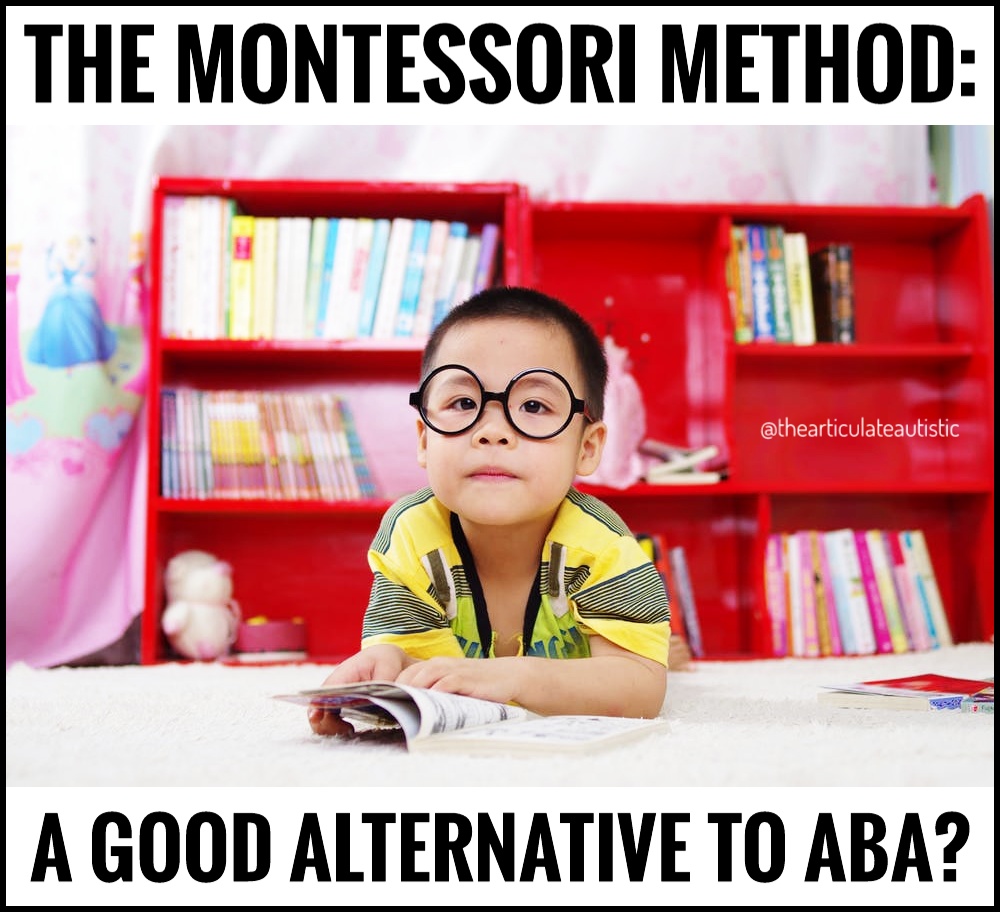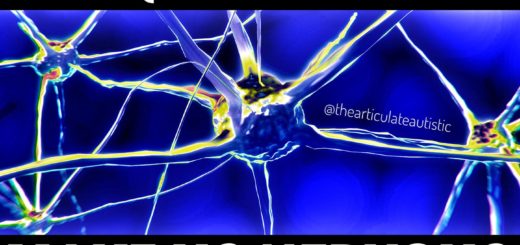The Montessori Method as an Alternative to ABA for Autistic Children

Traditional educational settings can be stressful and challenging for autistic children and young adults. The required conformity, inflexible routines, and social expectations of a traditional classroom can cause distress and hamper learning, development, and enthusiasm for a neurodivergent child.
For many autistic children, ABA (Applied Behavioral Analysis) is often the first recommended suggestion after diagnosis. ABA, along with other therapies, is utilized by practitioners to make an autistic child learn neurotypical facial expressions, body language, and social skills which won’t come naturally to them.
Many believe that this manipulation of the child is an unacceptable attempt to “normalize” their behavior and make it more socially palatable to their neurotypical peers.
While ABA breaks tasks into small steps, with rewards given for each achievement, parents raise doubts about how useful these skills are in the real world and whether children could transfer what they’d learned with a therapist to a natural environment. For example, a child might know when to look a therapist in the eye at the table, especially with prompts and a reward, but still not know what to do in a social situation as these situations often change and are not scripted.
Furthermore, the aversive training parts of ABA therapy rightly attract criticism. The idea of punishing children for perceived ‘bad’ behaviors such as hand-flapping, vocal sounds, and other types of stimming is hard to stomach. Parents want the best for their children, but what does that look like for each child?
Maria Montessori, a respected expert on child development, founded the Montessori curriculum. The ethos is that every child goes through a unique development process and is a unique individual who can learn in line with their own capacity, whether autistic or not. This belief, that knowledge requires more than simple memorization of educational material, underpins the curriculum.
Montessori insisted that knowledge should be made specific enough so that any child of any age can understand and learn, which led to the development of the method and series of materials that can be integrated into the classroom setting.
The Montessori curriculum differs from the mainstream curriculum which focuses on children learning the same thing, at the same time, in the same way. It emphasizes learning as a process that cannot be determined by a child’s age. Instead, learning is determined by the rate and speed at which a child can acquire one skill before moving on to the next. It is common to see mixed-age groupings in Montessori classrooms, where a 2-year-old may be in the same classroom setting as a 4-year-old, based on their developmental ability. This approach is ideal for many autistic children as it allows them to learn and develop at their own pace in a supportive and unpressured environment.
Many aspects of a Montessori education may benefit autistic children more than neurotypical children, starting with the interactive, sensory-utilizing, and calm method of learning. The prepared environment of the Montessori classroom provides a consistent, unchanging, and safe environment where children can benefit from watching other children choose and participate in activities before they get involved themselves.
This is very important for autistic children as they prefer to observe many times before they make their own attempt. In the Montessori classroom, this is not only acceptable but encouraged, and children will never be forced into an activity.
Currently, there are over 4,000 Montessori schools across the USA who adopt the main principles of Montessori education and, most importantly, ensure all children are respected for their individuality. An effective teacher in the Montessori classroom serves more as a guide, whose responsibility is to observe children choosing their work and to identify what motivates them.
The Association Montessori International website is an excellent resource, listing infancy, primary, and elementary providers who meet the rigorous requirements. Getting local recommendations and visiting providers is essential before making any decisions; parents know their child best, after all.
If there is not an appropriate provider nearby, the Montessori curriculum is simple to implement at home. There is a wealth of information available online, and many resources, but there are key areas to focus on.
For example, the organization of the environment allows the child access to toys that are stored at an appropriate height and accessible to them, and toys and books can be rotated to keep the child interested. Emphasizing life skills and allowing the child to help and be involved in daily tasks, from self-care to feeding is another important area. Teaching concentration and keeping the focus on inner motivation, not rewards, are the other main areas to follow.
There is a degree to which children have to be self-motivated to learn, and it will not be suitable for all autistic children, but it represents a genuine option for parents who feel that they want a different outlook and a fresh approach.
Learn More About Montessori!
Video Series
Ashley teaches her two daughters (both presumed neurotypical) at home using the Montessori Method.
Helpful Books
Tools & Toys



As someone who is both neurodivergent and went to Montessori schools from pre-K all through 5th grade, this is both amazing and unsurprising. I hope more people are able to experience this type of education, especially those who would otherwise be treated horribly with ABA.
I’m so glad it worked out for you. Thank you for sharing!
Whoa! I use ABA methods in an extremely positive way. I never punish, rarely use consequences and my clients are happy & thrive. I do not believe that you truly understand ABA and or have had some bad experiences. While I greatly appreciate the Montessori method, not being able to use certain evidenced based ABA methods with kiddos who engaging in target behaviors can become a real issue. If Montessori methods are not working and positive ABA methods are being shunned, it makes Montessori appear overly dogmatic and can actually prevent the child from improving. I don’t understand the complete resistance to ABA & evidenced based methods.
I’ll tell you where the complete resistance comes from: Hundreds of thousands of autistic adults who have received ABA training who now have complex PTSD. The stories out there are horrific, and it only takes a little digging to find them. While I understand the some of the methods, in and of themselves (redirecting harmful behaviors, for example) are not abusive, the entire purpose of ABA is to change the child and make them appear more neurotypical. There is no thought to the feelings and experiences of said child, just the idea that changing their outward behavior will make them less “difficult” for society to deal with. That type of thinking is dangerous, wrong, and abusive at its very core.
You can get PTSD from regular school. Just ask any person about their experience at school. I still remember how my Kindergarten teach shook me for not knowing what the dates of the month meant. I seen the other kids changing these numbers once a day at the beginning and I had no idea what they were doing. It was the date. After that I went home and asked my mother and she explained to me what they were doing. I have had some awful teachers. I asked my grade 4 teacher why you couldn’t breath after someone punched you in the stomach. He laughed at me and said “you had the air knocked out of you.” and all the other kids laughed at me. But the correct answer was that your diaphragm was stunned by the hit and it took a few seconds to recover so you could breath again. So the asshole teacher didn’t answer my question and make a laughing stock out of me. I can go on and on about how school can traumatize everyone. Not just me. Another one is practicing piano. Kids want to learn piano when they see how nice it sounds but no kid wants to practice and the parents must force it. In fact if kids are not forced to do homework , they won’t do it. This is similar to ABA where there is reward and punishment. I hated school, just like most kids but you learned from it and got skills.
I agree with you. School is traumatizing for many, especially us neurodivergent folks. I’m so sorry those things happened to you. 🙁
You can get PTSD from regular school.
And through the same means: being the target of bullying because someone else views you negatively. However, your comparing ABA to grade school, for example, is a whataboutism that is harmful to autistic people, ADHDers, and people with intellectual disabilities because regular school doesn’t recommend up to 40 hours per week of bullying the way that ABA providers do.
…sounds like you’re the one who doesn’t understand ABA if you don’t understand the resistance. It’s pretty obvious to Autistics. I can only assume that you’re not and therefore cannot grasp the full reality of behavioural change towards those that do not come naturally to you.
If you’re concerned with harmful behaviours, there are maybe 12 different things other than ABA that help with that and do it better due to the inclusion of education, language development, child psychology, neurology and biology underpinnings that cause these professionals to do the one thing you don’t… understand what the behaviour is for.
To target a behaviour without understanding why it’s expressed is unethical, dehumanising and ignorant, and the idea people such as yourself can determine what is considered “appropriate” behaviour as though we cannot determine that for ourselves, like our opinions don’t matter, is arrogant and paternalistic.
This is why I have started a Facebook group for parents/carers of kids who have been made to feel like they’re not good enough as who they are. Ant attempts, no matter how positive, to try and “fix” a child to “help” them be more “normal” are so extremely damaging on a phycological level. Why is eye contact made to be so important? Did you know it’s actually disrespectful in some cultures, and we don’t need to look someone in the eye to learn? In fact it can be so traumatising that it will actually inhibit our ability to absorb what is being said to us. And flapping, clicking and vocalising (various forms of stimming) are self-regulation tools and should be embraced as a wonderful tool for us to feel safe. If a child is hurting themselves or others, should be the only time any intervention is used…..ABA is conversion therapy. Autism isn’t less, we aren’t broken and we don’t need fixing. Love us for who we are, we are all just different.
I have been teaching in an AMI Montessori elementary classroom for over twenty years and I have found that this pedagogy works wonders for children who are diagnosed with ASD. Dr. Montessori first designed her methods–both the didactic materials and the philosophy of meeting children right where they are–while observing and working with special needs children (who were called “defective” at that time, left to sit idly because it was thought they were incapable of learning). She saw that these children were so bored that they would play with the crumbs of food that were left on their table after a meal. She introduced both toys and hands-on materials for learning and those children were much more drawn to the learning materials. These students began to test at the same level as the “neuro-typical” (and I use that term lightly because I don’t think there is such a thing) peers. Thus, she further developed a curriculum that was based on how children’s brains learn best and that the methodology was created to function for any student, at any place in time, in any setting, with any brain.
I have had quite a few students that were diagnosed with ASD. I’ve taken a course at the University of Washington on Autism Spectrum Disorder, including instruction on ABA, FBA data collection, antecedent-based interventions, and evidence-based practices for behaviors and cognitive learning. What I know to be tru is that in an authentic Montessori environment, we can meet ANY child where they are and help them meet the goals that they and their families have for them.
For instance, I had Marcus, who started in 3rd grade, having come from public school and who spent every Friday in ABA therapy rather than in class. My 1-3rd grade class would provide a hot meal every Friday (we didn’t have a cafeteria so children brought lunches from home on other days) of beans and rice. The children who volunteered for the committee took orders from the other classrooms and from the other adults that worked in our building. They collected and kept account of the money they collected (it was all cash so they had to make a lot of change). They did some math to figure out how many servings they’d need then they’d go to the grocery store to get all of the ingredients. They gathered the ingredients, paid for the groceries, and then carted the bags from the store two blocks away. The next day (Friday), the children would cook the beans and rice, set up all of the accompanying sides (guak, sour cream, hot sauce, pico, etc.) and then serve all of the children and adults who had ordered. The adults often had difficulty getting out of their classrooms to get their portion so that committee would serve their bowls and deliver it to them. You can imagine all of the social skills and problem solving that would happen each week! It was magnificent!
Because Marcus was working with a therapist on some of his social skills every Friday, he was missing out on this wonderful opportunity to interact, work as a team, follow through, and see all of those skills modeled by his peers. His parents agreed to let him join us on Fridays and Marcus positively thrived! He wasn’t very verbal (he was capable but just didn’t use his verbal skills like many of his peers did) but he sure did when he was doing our beans and rice meal! He practiced making eye contact, using social greetings and graces, and connected with so many students and staff during these times. Because he had a real passion and some serious skills in math, the kids loved having him on their team. The ABA skills he’d been learning certainly gave him a foundation, but his applying those skills in real time, for real reasons, helped not only build his skill, but build his confidence, esteem, and community.
I don’t jump to conclusions about why any of you wrote what you did; nor do I take offense to any opinion stated here. But I am delighted that you wrote this article because I have had a few parents, who’s children were diagnosed with ASD, who were told by their child’s therapist that a Montessori class wasn’t a good fit for children with autism. And I’ve never understood that. We meet every kid where they are and we have the utmost respect for children. We have flexibility and we understand that each child should be allowed the space and freedom to learn and grow they way they do it best. We work with the whole family to the benefit of each child. If we dedicate ourselves to these practices, every child will thrive.
Sounds like the perfect spot for a child with ASD. 🙂
Thank you for your comment. I am currently researching schools for my autistic child and want to make sure they have a methodology that doesn’t aim to “fix” him. I love that my son has found ways to regulate himself and that he is naturally inquisitive and creative. I am homeschooling until I find the right school for him. So far it’s between Montessori, Steiner or a community school. Montessori are the most expensive option out of these, but possibly also the best.
You can Montessori homeschool, if the price is out of your budget. That is what I will be doing with my kiddos!
FALSE! ABA is NOT for stimming or anything that is not HARMFUL. ABA corrects aggression, self injury and mural action, inappropriate touching or exposing, property destruction, behaviors like that. Punishment is not taught or encourage so please stop with the lies. It’s incredible, the amount of false information that’s floating around and so many people believe it.
As Black women, we carry with us a profound and tumultuous history in our interactions with the field of obstetrics and gynecology—a narrative marked by darkness and strife. Yet, amidst these shadows, our collective response does not manifest in sweeping condemnations or debates over completely disengaging from these crucial medical services. Our approach is not to vilify those who find worth in these fields. Instead, we delve into the depths of our history, share our personal narratives, and actively advocate for the betterment and evolution of this medical discipline. We recognize its intrinsic value, refusing to negate its significance due to its troubled and, at times, painful past.
Therefore, I urge a similar perspective in discussions about Applied Behavior Analysis (ABA). The focus should shift from dwelling solely on negative experiences to understanding the foundational science that underpins it. Engaging in futile arguments is akin to shadowboxing—an exertion with no tangible impact. As a devoted advocate for this field, I am committed to promoting the scientific basis of ABA and dispelling misconceptions. ABA, with its evidence-based approach, is an enduring and vital element of our toolkit.
So any parents of kids or young adults who have recently partaken in ABA who claim these skills, such as eye contact, stimming etc are being manipulated with this therapy style are lying. Practices who use ABA make claims around how important eye contact is and that it IS one of their focus points, are they lying too? Are the many people who have experienced this who have have c-ptsd also lying?
Also…..any reward/punishment approach carries developmental risks. A good book that explains this is written by Alfie Kohn, a well respected author with years of scientific research backing his claims, and they actually make sense.
FALSE! ABA is NOT for stimming or anything that is not HARMFUL.
<a href="https://www.neurodiversity.net/library_lovaas_1965.pdfLovaas, Schaeffer, and Simmons would very much beg to differ, as would the <a href="https://en.wikipedia.org/wiki/Judge_Rotenberg_Center. You can stop defending your favourite method of torture now.
Wow, wonderful blog structure! How long have
you been blogging for? you made running a blog look easy.
The whole look of your site is magnificent, as smartly as
the content! You can see similar: dobry sklep and here ecommerce